Roosters are a necessary evil on the homestead. Yes, I am classifying them as evil – I wouldn’t have a few months ago, but this last rowdy row was sentenced to the freezer early because I had simply had enough of his attacks on, well… every person and critter who walked within 40 feet of him on the homestead.
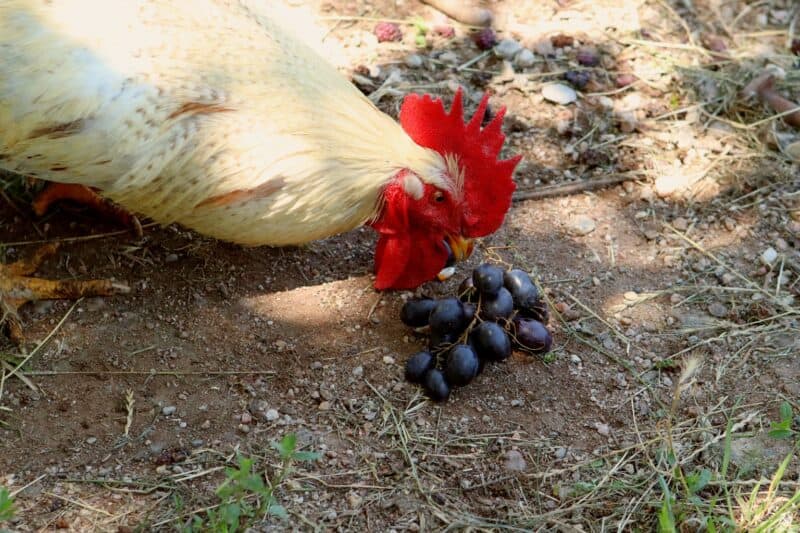
I had a tiny assassin on my hands and he had to go.
A rooster is needed to do only two things: procreate and guard the flock. That’s it, and I know that is it. I do not expect my rooster to want to hang out, get petted, pose for cute photos, or anything out of the ordinary.
I just want them to do their job without frequently drawing blood on folks and livestock I care about. Is that too much to ask? Well, the Buckeye rooster I put down several weeks ago would likely nod in the affirmative if it was still breathing.
As chicken keepers, it is our goal to keep flocks that are calm, productive, and safe to be around. There are some chicken breeds of which the hens are good layers (or perhaps even fantastic!), but the males are so downright mean it’s hard to keep them around.
Examples include the Malay chicken and the Asil chicken breed, both of which are jungle fowl breeds that are known for their flightiness and aggression.
If you’re looking for roosters that will stay calm and provide your flock with what it needs – protection without quite so much meanness – then you’ll want to consider one of these 15 rooster breeds described below.
Table of Contents:
The Best Rooster Breeds
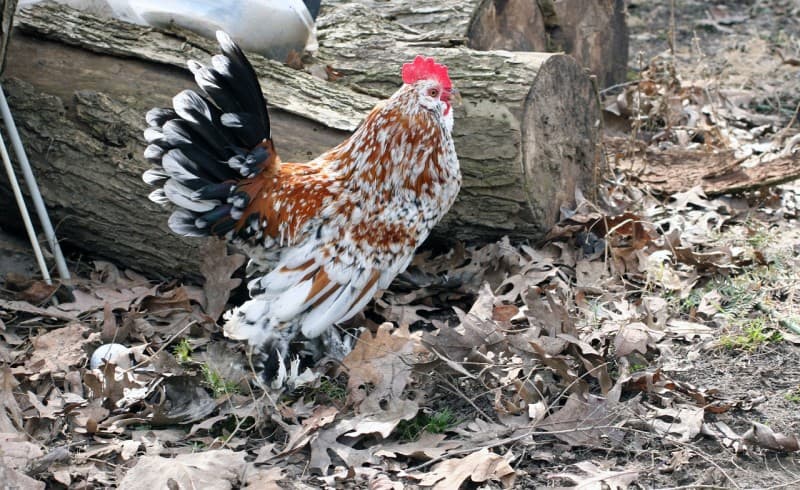
1. Bantam Roosters
This is a small breed of chicken that has long been a staple on many farms and homesteads. The hens lay only medium white eggs, but they lay them in great abundance and are excellent sitters.
Many folks keep banty hens and their rooster companions simply because they will not only sit their own eggs, but those from other birds in the hen house as well.
Bantam roosters are beautiful in both color and personality. This breed of poultry birds matures in as little as seven months, they are excellent foragers and free rangers, and, best of all, can clearly differentiate between keepers and a true predator.
Not a single Banty rooster that we have ever had or known of, has attacked a single time. Unlike roosters of other breeds, Banty roosters do not mind the occasional affection from keepers.
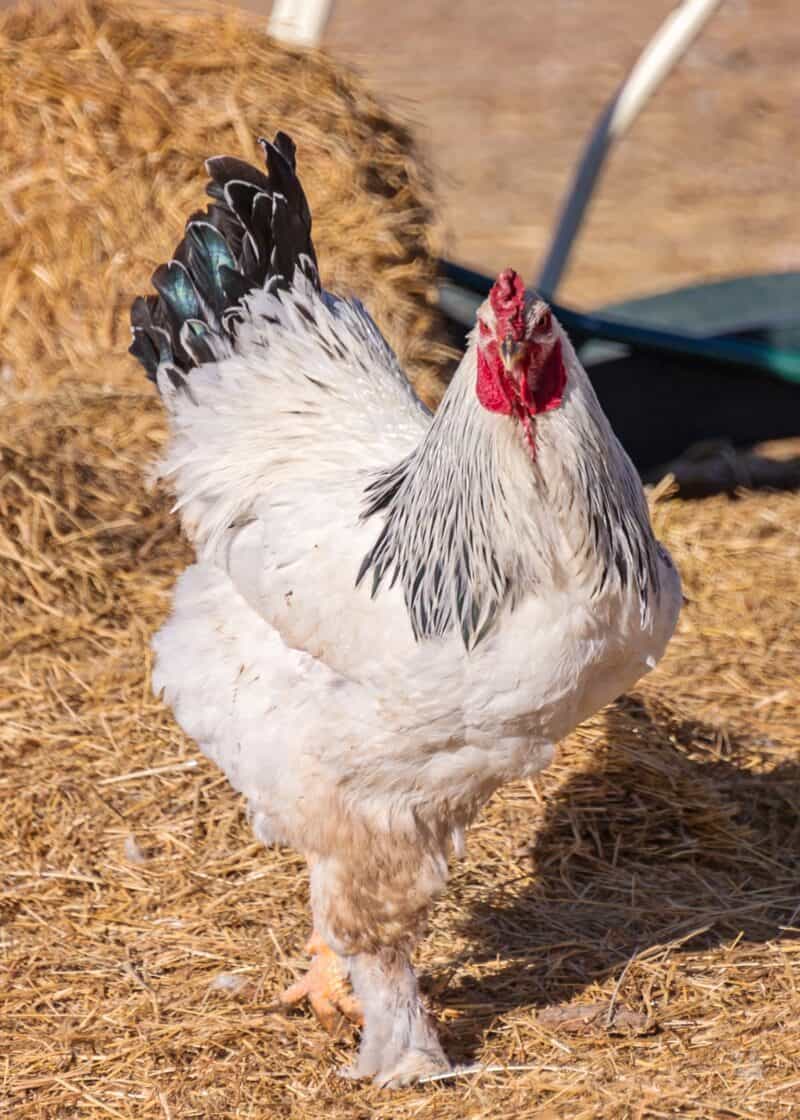
2. Brahma Roosters
Roosters (heck, even hens) of this chicken breed can often intimidate newbie keepers because of their monstrous size. However, Brahma roosters are often gentle giants.
They are also commonly referred to as the “King of Chickens.” Brahma chickens and roosters were the largest of all the poultry bird breeds until the Jersey Giant were created.
It is not unusual for a Brahma rooster to stand over two feet tall! You will likely get hours of enjoyment merely watching them amble around the chicken run or backyard.
They are decidedly docile and intensely protective of their hens against real predators. Like Bantam roosters, Brahmas quickly learn to trust their keepers and realize they are THE source for food, water, and help when a member of the flock is sick or injured.
3. Australorp Roosters
These nearly all black roosters are sleek and savvy. They are often shy at first, which can be misinterpreted as a pre-attack sizing up of their keepers. But, Australorp roosters have a solid reputation for becoming and remaining docile and even friendly with their keepers.
It is not unusual for Australorp roosters to wander over to a keeper in search of a treat, if the flock free-ranges. Roosters of this breed are often seen patrolling back and forth around the perimeter of the chicken run or the free ranging hens to keep an eye out both on land and in the sky for potential threats.
An Australorp rooster even pecks out some nice worms and bugs from the ground and gives them to his ladies – before eating some for himself.
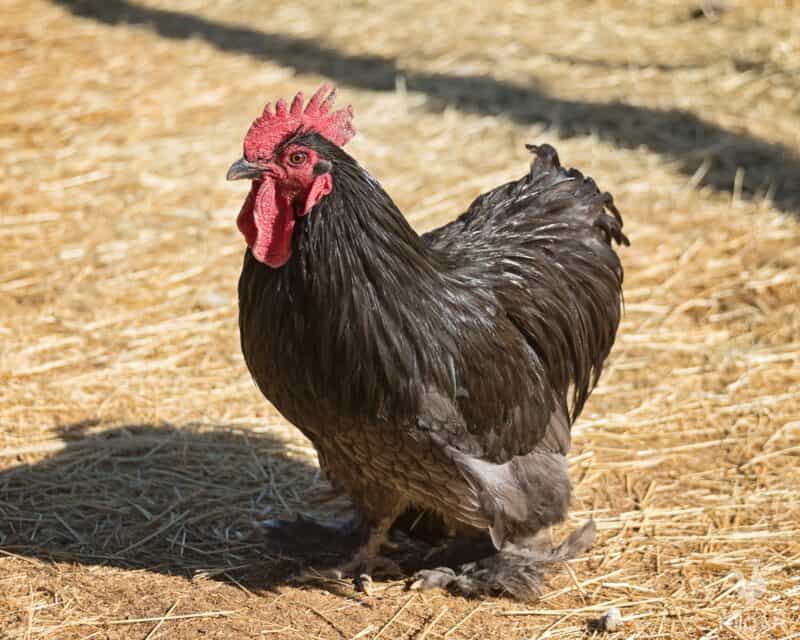
4. Cochin Roosters
These fluffy roosters often appear to have fur instead of feathers thanks to the ultra fluffy feathers they possess. Some keepers have even claimed that a Cochin rooster will indeed defy convention and sit in your lap and feel right at home sitting on the porch and hanging out with the homesteading family.
While being this docile might make a Cochin seem like the best rooster choice for your homestead, especially if you have young children, that might not be so.
A rooster that is this friendly and willing to go hang with the folks and be petter is neglecting one of his most important jobs – looking after the hens.
If the flock will be kept inside a coop and run all the time, keeping a Cochin poses less of a problem from the predator front – unless a mink, weasel, or similar small predator finds its way inside.
To help keep the hens safe if you decide to go with a pretty Cochin rooster, purchase some guineas and keep them in the coop or establish them outside around it so they can be the watchkeepers for the poultry birds.
5. Barbu D’Uccle Roosters
This is another small breed of rooster. These small stature Barbu D-Uccles should not be misjudged by their size, they are more than willing to put up a fight in defense of their hens.
A Rooster of this breed is known to stick by the sides of his hens while they roam about and forage, remaining alert even when he himself pecks around for some food. If he senses or sees danger about, a Barbu D’Uccles rooster will make a good bit of racket while his ladies scratter to safety.
These small roosters are also prone to fighting any aggressive larger rooster… and win. The only aggressive behavior you should expect from a rooster of this breed is during mating season – which is commonplace for a rooster of any breed.
Before and after mating season, many of these little roosters are willing to be picked up and handled by keepers.
6. Buff Orpington Roosters
Hens of this breed are quite popular throughout the Midwest – and likely far behind. Roosters of this breed are nearly equally as friendly and docile when handled. Some Buff Orpington roosters even seek out the attention of their keepers.
But, when the hens are out free ranging or milling about the chicken run, these pleasant roosters will be ever watchful for threats, and ready to attack to defend their flock if necessary.
When danger is present, Buff Orpington roosters will alert you by making a lot of noise. This same clatter indicates to the hens it is time to move to safety.
7. Polish Roosters
These rather odd looking poultry birds boast some especially docile roosters among their ranks.
I doubt you could find a more respectful rooster, he is quite the gentleman to his ladies. Mating can be a somewhat uncomfortable experience for the hens with roosters ripping their backs bare of feathers while making little chicks.
You won’t catch a Polish roo roughing up his ladies. In fact, sometimes it appears that the hens rule the roost and the rooster is simply doing their bidding.
All of those floppy feathers that hang down in front of their faces can obscure their vision and may need to be trimmed.
A rooster with a lot of feathers hanging down can begin to get jumpy and agitated at not being able to keep proper watch over the hens and being unable to determine if any of the noise he is hearing but not seeing, could pose a threat.
8. Java Roosters
This chicken breed was once one of the most frequently kept in America. Sadly, their numbers have dwindled and may make finding a Java rooster a bit of a difficult process.
The average weight of a Java rooster is nearly 10 pounds, making him an intimidating sight for many small yet deadly predators. Like the Brahma, a Java rooster is often dubbed a gentle giant.
Birds of this breed are great foragers and flock protectors. Even though keeping the hens safe never strays from a Java roo’s mind, many roosters of this breed become so friendly with their keepers they will readily accept handling and mild affection.
9. Faverolles Roosters
Roosters of this breed do not closely resemble their hens, and nearly all other breeds do. You will quickly be able to tell where your roosters is at all times – and he will be a beauty. Faverolles roosters are excellent hen guardians and remain on alert for danger 24/7.
A rooster of this breed is often friendly towards keepers, but is not eager to be picked up for affectionate exchanges. A Faverolles rooster is often a curious bird that likes to investigate his surroundings, and go on frequent perimeter patrols.
10. Delaware Roosters
Chickens and roosters of this breed have sadly found their way onto watch and fragile lists after enjoying many decades as a popular poultry bird choice across America.
Both the Delaware roosters and hens are beautiful birds. The only time a roo of this breed tends to be prone to aggressiveness is when it is startled. Typically, Delaware roosters are docile and respectful of their keepers.
These roosters are exceptionally attentive to their hen protection duties. If a threat is posed, they will make a lot of noise, and then herd the flock safely away from danger.
Delaware roosters have often been bred with either Rhode Island Red hens and New Hampshire hens to create sex-linked chicks. This means the color of the hatched chicks is differentiated by sex – allowing you to easily tell which of the new little birds will become a hen or a rooster.
11. Langshan Roosters
This is the third gentle giant of the poultry world entry of our docile roosters list. Langshan roosters typically stand roughly between two feet and 32 inches tall, but weigh merely nine pounds, on average.
No one wants a mean rooster of that size – and you are not likely to get one if you purchase a Langshan.
Roos of this breed are excellent free rangers and foragers. Even though they love to forage, Langshan roosters do not take their eyes off of the hens.
They are very laid back roosters, not the type to run at top speed unless motivated to do so by a predator threat. Instead, these rather majestic-looking poultry birds saunter about while patrolling their chicken kingdom.
12. Barred Plymouth Rock Roosters
One of the reasons members of the Plymouth Rocks breed became and remained so popular is because of their intense work ethic. Plymouth Rock flock members have often been dubbed the “workhouse” of the chicken world.
If allowed to free range, these birds will work diligently to rid your homestead of bugs. Many folks choose Plymouth Rocks even if they have no intention of doing free ranging simply to keep a breed with a mellow and docile rooster.
Roos of this breed are steadfast in their determination to keep the hens both safe and hatching fertilized eggs. Plymouth Rock roosters are fairly intelligent birds, and seem to be able to tell the difference between a real threat and the keepers who bring them food and water on a daily basis.
13. Welsummer Roosters
It is not uncommon to see a Welsummer keeper hand feeding his or her rooster treats right from the palm of their hand. Sometimes, a rooster of this breed will walk over to initiate friendly contact with a keeper – of course, hoping for a bonus treat.
Welsummer roosters are content to keep a watchful eye on their hens, often darting back and forth between each one – no matter how far apart they wander while foraging, just to seemingly give each other a little personal attention, and make sure all is well.
These roosters will definitely set off the alarm bells when they sense a threat, and always be the last bird to go back inside the coop after putting out the predator alert.
14. Sebright Roosters
These small banty size roosters have a lot of spunk. They will take on any predator that threatens their girls. Because Sebright roos are especially protective of their hens, it is best to handle them often as chicks so they get to know you and everyone else on the homestead who will come into contact with them on a routine basis.
As long as you raise Sebright roosters from chicks to maturity, they should be comfortable with the fact that you bring safety, food, water, and the occasional treat, and not threats of harm.
These roosters are fun to watch and interact with the flock and other barnyard critters. Their outgoing and chatty personality is clearly evident, especially for roos that also welcome some interaction with their human keepers.
15. Rhode Island Red Rooster
When it comes to aesthetics, the Rhode Island Red does not disappoint. This fowl has an unmistakable look that stands out from all other chickens in terms of color and size. With its bright red feathers and large comb and wattles, this is one good-looking bird.
And even though they are larger than most breeds, they don’t take up too much space on the farm.
The Rhode Island Red also has a reputation for being a very hardy breed. This means that they are able to survive in most climates and conditions. Whether you live in a hot climate or cold climate, these birds will thrive as long as they have adequate shelter and food.
Furthermore, these birds can adapt to different types of farming operations easily—from free range farms to close confinement —the Rhode Island Reds will do well in any environment. We’d be careless if we didn’t mention that the females are some of the best egg layers, too!
All Roosters Have Their Pros and Cons
When we moved onto our dream survival homestead four years ago I had a chicken phobia to get over. I was chased by chickens (probably some roosters too) on my grandparents farm when I was little.
My big brothers laughed, and were absolutely no help as I ran and ultimately sliced both of my knees open on concrete steps. So, to put it mildly, I was leary about roosters when we started this self-reliance lifestyle.
But, until recently, I had ZERO problems with roosters. My first rooster, Flock Leader, was dreaded by everyone who was over three and a half feet tall that wasn’t me.
He, unlike the Buckeye rooster, was not in constant attack mode – and would run up to 100 feet from the hens to flog anyone who might even be thinking of walking past the coop.
Flock Leader was a White Leghorn, they are known to be extremely aggressive roosters. But, he would fly up onto my shoulder not to attack, but to get a chance to peek down into the feed tub and be the first to eat each morning.
I hand-fed the Flock Leader treats just as I had with the two Buckeye roosters who turned downright evil… Yes, I am standing behind that characterization of these beautiful birds – that I had raised from chicks.
Sometimes, breed does not matter. Until the Buckeye rooster – both the first one I killed and the second I killed more recently, were as docile as hens… until they weren’t.
If you want to avoid rooster rage as much as possible, buy one of the breeds noted on this list, But, remain keenly aware that simply getting one from a breed that is known to be docile will not guarantee you do not have to be quick on your feet and keep a baseball bat in your hand to leave the coop area unscathed.
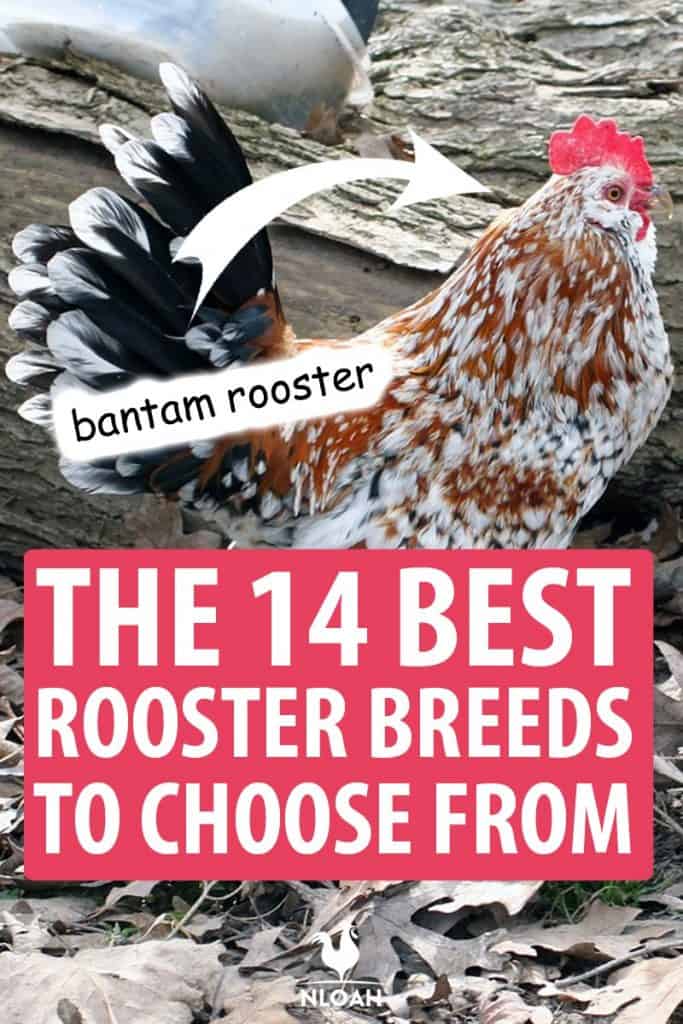

Tara lives on a 56 acres farm in the Appalachian Mountains, where she faces homesteading and farming challenges every single day, raising chickens, goats, horses, and tons of vegetables. She’s an expert in all sorts of homesteading skills such as hide tanning, doll making, tree tapping, and many more.

Roosters are such unpredictable birds. I have often wonder male ducks and guineas are not aggresive like roosters. My guineas are my barnyard assassins and will attack any threat of any size, but are always docile with two legged visitors – as are my sweet and cute ducks.
Yes, much depends on a rooster’s individual personality. I’ve only raised Barred Rock roosters (until this year’s pair of mutts which may be freezer bound) Each of my Barred Rock roosters have been different. One was very aggressive toward his keepers. Another was only moderately so, but always testing to see if he might move up in status. This year’s Barred Rock rooster is ideal. He’s always on guard, good to the girls and respectful of his keepers. They’re each different.